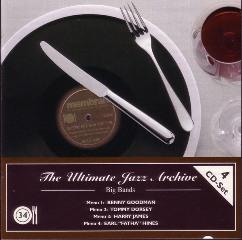The Ultimate Jazz Archive Vol.136 – Earl ‘Fatha’ Hines [1937-1946] [2005]
The Ultimate Jazz Archive Vol.136 – Earl ‘Fatha’ Hines [1937-1946] [2005]

01.Rhythm Sundae 02.Pianology 03.Piano Man 04.Tantalizing A Cuban 05.G.T. Stomp 06.Lightly And Politely 07.Boogie Woogie On St. Louis Blues 08.Deep Forest 09.Number 19 10.Call me Happy 11.Easy Rhythm 12.Comin’ In Home 13.Up Jumped The Devil 14.Jersey Bounce 15.South Side 16.Windy City Jive 17.Swingin’ On C 18.The Father Jumps 19.The Earl 20.Blue Keys
Earl Fatha Hines (1903-1983). Pianist and band leader.
Earl Hines studied trumpet briefly with his father and took his first piano lessons with his mother, later studying with other teachers in Pittsburgh. He first played professionally in 1918, accompanying the singer Lois Deppe, with whom he later made his first recordings. His earnings allowed him to study with two local jazz pianists.
Hines moved to Chicago in 1923 and during the next few years played with several important Chicago bands: Sammy Stewart's (at the Sunset Cafe), Erskine Tate's Vendome Theater Orchestra, and Carroll Dickerson's (on a 42-week tour). In 1926, Dickerson's band returned to the Sunset Cafe and, with Hines, Louis Armstrong , and other important musicians, soon became well known, influencing a generation of musicians. Hines became its director in 1927 under Armstrong's nominal leadership. After an unsuccessful attempt to manage their own club in 1927, Armstrong and Hines separated, Armstrong returning to Dickerson, and Hines joining Jimmie Noone's band at the Apex Club. In 1928, Hines recorded several titles with Noone, including Apex Blues, and made a series of influential recordings with Armstrong, among them the highly original trumpet and piano duet Weather Bird. He also recorded a group of solos for QRS.
On his 25th birthday, Hines inaugurated his own band at the Grand Terrace in Chicago, where he played for ten years. The band became known through nationwide tours and, from 1934, radio broadcasts. Until 1948, he continued to lead big bands, featuring such important figures as Billy Eckstine, Sarah Vaughan, Charlie Parker , Dizzy Gillespie, and many others. From 1948 to 1951, Hines played with Armstrong's All Stars and afterwards worked with small groups led by himself and others, attracting critical notice in the mid-1960s for his solo, trio, and quartet playing. Hines led his own small band into the 1980s and continued to perform regularly in the USA and abroad until the weekend before his death.
One of a small number of pianists whose playing shaped the history of jazz, Hines was an ensemble pianist from the beginning of his career (unlike many earlier pianists, primarily soloists who adapted to ensemble playing). Many pianists of the time, particularly in the Midwest, had largely eliminated ragtime influence from their right-hand techniques, preferring a sparse linear approach to the thicker texture of ragtime and integrating the piano with the ensemble. Hines's version of this, present in nascent form in his earliest recordings, is often called "trumpet style": clearly articulated melody without ragtime figuration, often played in octaves, and tremolo approximating wind vibrato. The left-hand technique of the period was similar among pianists of otherwise widely divergent styles — a single note, octave, or 10th on the strong beats of the bar, with a chord, usually centered about c', on the weak beats; the result was an explicit statement of the pulse. Hines, using 10ths a great deal, took this common technique as a point of departure, interrupting its regularity to play off-beat accents and to contradict or all but dissolve the meter.
These qualities were already apparent in his early performances with Armstrong, as shown by his famous break in Skip the Gutter. Into the 1930s, he extended this device to produce solos of great textural variety. His playing was also characterized by the use of arpeggios through several octaves, intermittent silences, and constant attention to line, features impersonal enough, taken in isolation, to point out new directions to a generation of pianists.
Hines's ability to change his style but retain his identity as a pianist undoubtedly conditioned his attitudes as a bandleader. Over two decades he led innovative jazz groups, and he was among the few musicians of his generation to appreciate the new features of bop, which he introduced into his band through the presence of bop musicians. ---pbs.org
download: uploaded anonfiles yandex 4shared solidfiles mediafire mega filecloudio








